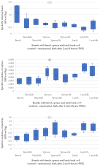Valorization of Extracted Bark for Particleboard Production: A Life-Cycle Impact Assessment
- PMID: 40219313
- PMCID: PMC11991010
- DOI: 10.3390/polym17070925
Valorization of Extracted Bark for Particleboard Production: A Life-Cycle Impact Assessment
Abstract
The enhanced use of wood residues from the timber industry contributes to mitigating the global climate crisis. Currently, bark, a by-product of the timber industry, is primarily burned for thermal energy generation. However, with the growing demand for lignocellulosic products and the emphasis on extending life cycles, it would be more beneficial to prioritize substantial uses of bark over thermal utilization. Although numerous methods for substantial bark utilization have been explored, a significant untapped potential remains. The extractives obtained through water extraction, for instance, can be applied to various further uses like biopolymers or medical applications. This study investigates the impact of hot water extraction on the mechanical and physical properties of bark-based panels, with the aim of extending the life cycle of tree bark and its valorization in bio-based composites. The findings demonstrate that hot water extraction can enhance the bending properties (modulus of rupture, modulus of elasticity) of bark-based panels. Additionally, the extractives obtained from the process have potential applications in the pharmaceutical and adhesive industries. The study also includes an LCIA that highlights the differences between the three scenarios addressed in this research, namely energy generation from bark-based biomass, extraction of bark, and use of extracted bark residues in the production of bark-based particleboard.
Keywords: LCIA; bark; beech; larch; material flow analysis; phenolic content; spruce.
Conflict of interest statement
The authors declare no conflicts of interest.
Figures









Similar articles
-
Leveraging Spruce Bark Particle Morphology for Enhanced Internal Bonding in Particleboard Production.Polymers (Basel). 2024 Oct 25;16(21):2988. doi: 10.3390/polym16212988. Polymers (Basel). 2024. PMID: 39518198 Free PMC article.
-
Evaluation of the mechanical, physical properties and decay resistance of particleboard made from particles impregnated with Pinus brutia bark extractives.Bioresour Technol. 2006 Nov;97(16):2059-64. doi: 10.1016/j.biortech.2005.09.013. Epub 2005 Oct 26. Bioresour Technol. 2006. PMID: 16256344
-
Sound-Absorption Coefficient of Bark-Based Insulation Panels.Polymers (Basel). 2020 Apr 29;12(5):1012. doi: 10.3390/polym12051012. Polymers (Basel). 2020. PMID: 32365459 Free PMC article.
-
Perspectives on Using Alder, Larch, and Birch Wood Species to Maintain the Increasing Particleboard Production Flow.Polymers (Basel). 2024 May 29;16(11):1532. doi: 10.3390/polym16111532. Polymers (Basel). 2024. PMID: 38891478 Free PMC article. Review.
-
Forest biorefinery: Potential of poplar phytochemicals as value-added co-products.Biotechnol Adv. 2015 Nov 1;33(6 Pt 1):681-716. doi: 10.1016/j.biotechadv.2015.02.012. Epub 2015 Feb 27. Biotechnol Adv. 2015. PMID: 25733011 Review.
Cited by
-
Valorization of Olive Tree Pruning and By-Products from the Truck Industry in the Manufacture of Low-Environmental-Impact Particleboard.Materials (Basel). 2025 Jul 10;18(14):3258. doi: 10.3390/ma18143258. Materials (Basel). 2025. PMID: 40731469 Free PMC article.
References
-
- Holubcik M., Jandacka J., Palacka M., Kantova N., Jachniak E., Pavlik P. The Impact of Bark Content in Wood Pellets on Emission Production During Combustion in Small Heat Source. Commun.-Sci. Lett. Univ. Zilina. 2017;19:94–100. doi: 10.26552/com.C.2017.2A.94-100. - DOI
-
- Krigstin S., Helmeste C., Jia H., Johnson K.E., Wetzel S., Volpe S., Faizal W., Ferrero F. Comparative Analysis of Bark and Woodchip Biomass Piles for Enhancing Predictability of Self-Heating. Fuel. 2019;242:699–709. doi: 10.1016/j.fuel.2019.01.056. - DOI
-
- Anerud E., Routa J., Bergström D., Eliasson L. Fuel Quality of Stored Spruce Bark–Influence of Semi-Permeable Covering Material. Fuel. 2020;279:118467. doi: 10.1016/j.fuel.2020.118467. - DOI
-
- Elisa P., Alessandro P., Andrea A., Silvia B., Mathis P., Dominik P., Manuela R., Francesca T., Voglar G.E., Tine G., et al. Environmental and Climate Change Impacts of Eighteen Biomass-Based Plants in the Alpine Region: A Comparative Analysis. J. Clean. Prod. 2020;242:118449. doi: 10.1016/j.jclepro.2019.118449. - DOI
Grants and funding
LinkOut - more resources
Full Text Sources

